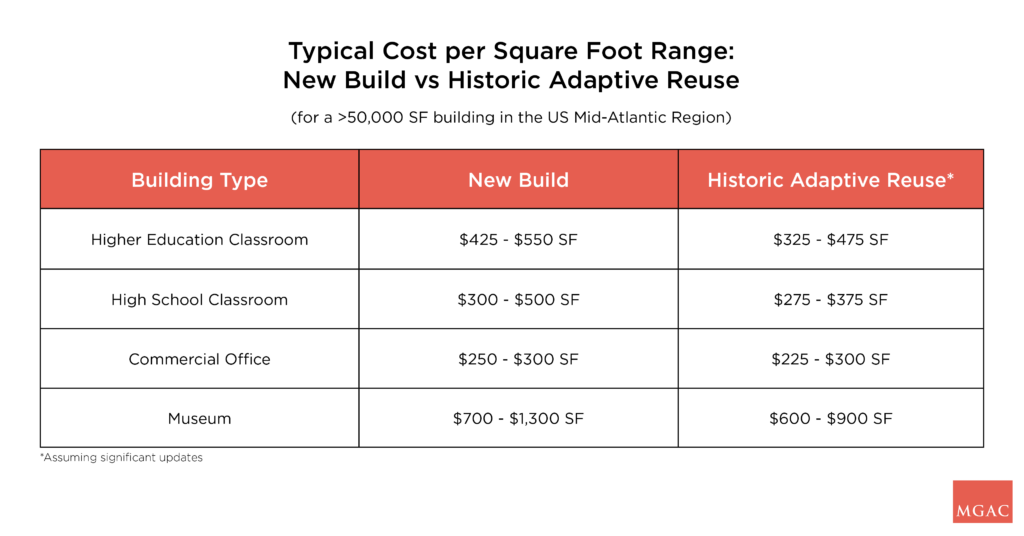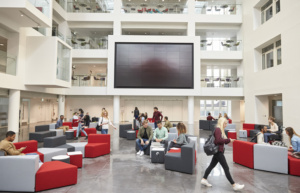Cost Drivers of Historic Adaptive Reuse Projects
An AIA article said it best, “Adaptive reuse breathes new life into old bones. It is a method of protecting historically significant buildings from demolition. It promotes sustainability and counteracts urban sprawl. Best of all, it challenges us to find value in the past and make it not just new again, but different and better.”
Historic adaptive reuse is the repositioning or reprogramming of a historic building for a new use, often incorporating the historic aspects of the original shell and interior.
The cost, environmental, and social benefits of historic adaptive reuse are well known among construction industry professionals, but these types of projects do come with a number of potential challenges and risks.
Successful historic adaptive reuse projects effectively plan for, mitigate, and manage such risks through strategic upfront investments, the most important of which is a very careful due diligence process. This article explains where due diligence efforts should be concentrated and highlight the potential cost premiums for specific areas/components in historic adaptive reuse projects.
Typical Cost Premiums vs New Build
Historic adaptive reuse project costs vary depending on the project type and degree of building preservation required. Costs can range from significantly more expensive to slightly less expensive compared to a similar new-build project. For building additions, such as a project that adds several modernized floors to an existing historic structure, project costs can be more expensive then a new-build. In an adaptive reuse repositioning project however, overall project costs are typically less than a new-build, especially after taking the land purchase price into account.
Although the unique existing conditions and planned programs of adaptive reuse projects make it difficult to provide cost benchmarks, the table below provides a rough cost differential for a new build and a significant historic adaptive re-use project in the Mid-Atlantic Region.

7 Specific High Cost Impact Project Areas
Some of the areas with the greatest cost premiums can be surprising to Owners, considering the majority of the building’s components are existing. In our experience, however, we find that much of building’s “bones” such as foundations, superstructure, and MEP systems usually require significant work or replacement. Cost premiums are often found in the following areas:
1.) Labor

Finely detailed interiors such as the one pictured above at Catholic University’s Father O’Connell Hall, create stunning spaces but can increase labor costs.
The cost breakdown for a historic adaptive reuse project is typically 60% labor/40% materials, compared to a typical new-build at 55% labor/45% materials.
This reduced productivity is due to challenging working conditions and the number of unknowns, hazmat abatement issues, and inefficient existing MEP pathways that crews must contend with throughout the duration of the project – factors that are covered below in more depth.
Spotlight: Logistics – Many historic buildings have smaller elevator shafts and no freight elevators, which can complicate and slow the process of moving construction materials. In order to maintain productivity, construction crews need to find creative solutions around limited access space.
On some MGAC projects, this has meant using existing or enlarged window openings to crane in materials or removing some of the roof slab or existing elevator pop-up to provide access. These costs premiums are typically reflected in the labor cost premiums or the contractor’s general requirements within transportation or rigging costs.
2.) Custom Materials
Windows, doors, and elevators are some of the most common components that need to be specially procured and installed due to historic and aesthetic requirements, logistical restrictions, and unique building dimensions.
Custom products may only have 1 or 2 vendors available to provide bids, which can reduce competition and increase the price. Because custom vendors usually work hand-in-hand with the team from preconstruction through design development, arming the Owner with relevant cost data can help to define and confine the budget earlier in the design. Without such data, Owners can get cornered later in the project when low initial contractor bids balloon throughout the design phase.

The irregularly sized window openings of many historic buildings can impact cost by requiring customized products and additional installation time. How many different window sizes can you count in this conference room?
Spotlight: Windows – Window openings on older buildings are typically not uniform in size and if the building is historic, the local advisory board may require replacement in kind or with an aesthetic match to the original. The 2 main cost drivers are the fact that window openings:
- Typically don’t match up to modern standard dimensions and/or are not uniform in size across the building. A significant amount of preparation and alteration may be required before installation.
- Are constructed from steel or aluminum. If the Owner is looking for the same durability, look, and feel, they may want steel replacement windows, which are usually significantly more expensive than aluminum replicas.
A benchmark range for aluminum windows is $100-140 / SF of window area and for steel windows $140-175 / SF of window area. Cost will vary depending on quantity, quality, number of panes and installation logistics.
3.) Structural Changes
Additions, expansions, roof gardens, reconfigurations are common in historic projects. These modifications have major structural implications that often require selective demolition, additional foundations, structural strengthening, underpinning, bracing, and possible code upgrades for seismic requirements.
About 75% of the adaptive or historic projects I have worked on have required structural upgrades, which range from just reinforcing some connections to underpinning the existing foundations and lowering the basement. Costs obviously will vary significantly.
4.) Hazmat Abatement
A reasonable benchmark range for a ‘typical’ historic building with lead paint, hazardous flooring materials, waterproofing or flooring mastics, piping insulation, and minor other miscellaneous items is between $2.5-6.5 / SF applied to the building floor area.
Depending on the extent of hazardous abatement required, however, the costs for removal can vary significantly. For example, on one higher-education project with minimal abatement including mastic on vinyl tile, some lead paint, and a small amount of piping removal, the cost was $1.75 / SF based on the building’s gross square footage.
At the other end of the spectrum, on a former university lab used for testing chemical weapons during World War II, the abatement cost was around $50 / SF before demolition even started.
5.) Basement and Foundation Waterproofing
Some Owners are reluctant to waterproof below grade because it is expensive and does not visibly help fulfill the vision or the program. However, waterproofing is often a necessary investment to protect the building. The cost can be extremely high if the whole basement needs waterproofing from the outside and even higher if the foundation requires treatment.
What we have typically seen (unless there is significant water penetration) is limited waterproofing on one side of the building and then interior water protection which may include sealant, interior drainage, or addition of sump pumps. Benchmarking, again, is difficult to set, but for waterproofing the basement wall excluding excavation the cost is around $10-15 / SF of wall area, depending on the application chosen.
6.) MEP Systems

Thick stone walls on some historic buildings can create challenges when routing new MEP systems.
Original MEP systems are typically outdated and in most cases, the equipment is replaced or the system is removed completely.
Issues are typically encountered when routing MEP piping because the existing pathway is not always the most efficient route. Many historic buildings have structural floor slabs made of material such as terracotta that may require costly reinforcements to cut openings for installation. The issues that commonly occur are difficult piping routes due to thick walls (includes conduits, ductwork, piping and risers), disturbance of HazMat materials, limited existing mechanical space volumes, insufficient power for the new program, and local reinforcement for the new equipment.
In some cases, however, these issues can be largely circumvented with non-traditional installation methods. On a current project, a 100 year old building with thick stone walls, our team needed to find pathways for ductwork. Rather than running conduits through the existing and fire proofing the openings, the engineer chose to go around the walls, which was quicker but required more material.
7.) Acoustics
Depending on the new planned use of the building, acoustics can be a cost driver that is often not identified until late in the Design phase.
On one recent MGAC project, historic building repositioned as a museum, the building required a set of interior windows inset from the existing historic windows to achieve the program’s acoustical and climate control requirements. Additionally, because the exterior façade and slabs were not thick enough to properly insulate sound, acoustical plaster and insulation needed to be applied. Obviously if these issues would not have been present in a new, purpose-built building.
Recommendations
The one-of-a-kind experiences created by historic adaptive reuse projects require an equally unique approach to building successfully and within budget. In any project incorporating existing components, due diligence is critical to managing risk and controlling costs. As imaging/scanning technologies such as LIDAR and other tools become available, project teams will be able to have increasingly reliable data, but some difficult-to-reach building components such as structural beams or foundations will remain a challenge. Having an experienced team in place and making the right upfront investments can pay dividends by helping mitigate potential issues later in the project.
In addition to taking steps early to manage risk, it is also important to plan for the unexpected issues and complications that will inevitably arise. When developing your project budget and schedule, I recommend setting aside an increased amount for:
- Change Orders – Change orders on historic adaptive reuse projects average 10-15% of construction cost, compared to 5-8% on new build projects. Spending time and money upfront on probes, surveys, and investigations can pay significant dividends as the project begins.
- Contingencies – On new projects, project contingency is recommended at approximately 3-6% based on project size and complexity, but on historic projects, a 7-10% is more prudent. The specific amount will depend on the risk assessment and the quality of existing documentation available such as original blue prints and previous building surveys.
If you have any questions about historic renovation or adaptive reuse projects or our cost data, please get in touch via LinkedIn or our Contact page.








